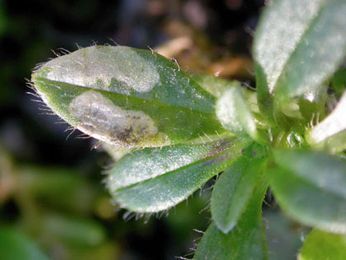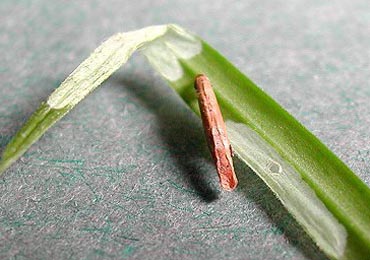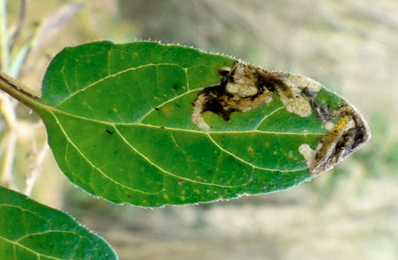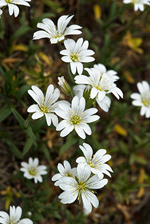|
||||||
|
CERASTIUM. Mouse-ears. [Caryophyllaceae] |
|
|
Fourteen species of Cerastium are recorded in Britain. These include the native Alpine Mouse-ear (C. alpinum), Arctic Mouse-ear (C. arcticum), Common Mouse-ear (C. fontanum), Dwarf Mouse-ear (C. pumilum), Field Mouse-ear (C. arvense), Little Mouse-ear (C. semidecandrum), Sea Mouse-ear (C. diffusum), Starwort Mouse-ear (C. cerastoides) and Sticky Mouse-ear (C. glomeratum). The BSBI provide a downloadable plant cribs for the identification of species of Cerastium. Fifteen British miners are recorded on Cerastium. Although the anthomyiid Delia florilega has been recorded on Cerastium in Britain and elsewhere, it is primarily a stem/petiole borer. The coleophorid Coleophora striatipennella is recorded as a seed-feeder on Cerastium in Britain and elsewhere. A key to the European miners recorded on Cerastium is provided in Bladmineerders van Europa. |
|
Key for the identification of the known mines of British |
Note: Diptera larvae may live in a corridor mine, a corridor-blotch mine, or a blotch mine, but never in a case, a rolled or folded leaf, a tentiform mine or sandwiched between two more or less circular leaf sections in later instars. Pupation never in a cocoon. All mining Diptera larvae are leg-less maggots without a head capsule (see examples). They never have thoracic or abdominal legs. They do not have chewing mouthparts, although they do have a characteristic cephalo-pharyngeal skeleton (see examples), usually visible internally through the body wall. The larvae lie on their sides within the mine and use their pick-like mouthparts to feed on plant tissue. In some corridor miners frass may lie in two rows on alternate sides of the mine. In order to vacate the mine the fully grown larva cuts an exit slit, which is usually semi-circular (see Liriomyza huidobrensis video). The pupa is formed within the hardened last larval skin or puparium and as a result sheaths enclosing head appendages, wings and legs are not visible externally (see examples). See Key to non-Diptera. |
1a > Stem miner: A shallow external stem-mine (Spencer, 1972b: 29). The mine generally starts as a fine, lower-surface, corridor the seems to end upon a thick vein. In reality the corridor continues by way of the petiole to the stem, where a very long mine is formed in the rind. Frass in widely spaced grains. Pupation within the mine, mostly just above a node; the anterior spiracles penetrate the epidermis. |
|
Ophiomyia melandricaulis Hering, 1943 [Diptera: Agromyzidae]. |
1b > Leaf/Stem miner: Eggs are scattered individually over the leaf upper surface; they are only loosely attached to the plant. The egg shell has a honeycomb structure. The larva begins with first mining one of the top leaves completely out. Next the larva moves down to another leaf, by way of a tunnel made in the stem. In this way several leaves are mined out, completely and full depth. In the attacked part of the plant the stem has become translucent; the damage causes the plant tip to wilt. In the first mines almost no frass is to be found, further down it is deposited in coarse grains. Pupation generally outside the mine (Miles, 1953). |
|
Delia echinata (Seguy, 1923) [Diptera: Anthomyiidae]. |
1c > Leaf-miner |
2a > Leaf-miner: Upper side blotch mine beginning with a deeper, almost full depth corridor. Frass grains not in thread-like pieces, irregularly scattered. In the large, later blotch indistinct primary and secondary frass lines are found; the frass accumulated in the middle. Each mine begins with one, rarely two, oval egg shells attached to the leaf underside. Sometimes a number of of young mines, and eggs, on one leaf. The first part of the mine is a tortuous corridor, quickly turning into a large blotch. Most of the blotch is full depth, only some patches are upper-surface, and greenish in transparency. According to the literature copious frass in present in dispersed lumps. In my experience the larva -that then looks very dark- may accumulate all frass in its body. The larva is capable of leaving its mine, and starting a new one elsewhere. These secondary mines can be recognised by the large hole that was made by the larva when entering. Pupation outside the mine. A gallery then a blotch, larger and deeper than Amauromyza flavifrons. In large leaves the mine is upper surface and all in one piece. In small leaves the whole leaf may be covered by a full depth mine with the larva mining several leaves in British leafminers. |
|
Pegomya flavifrons (Walker, 1849) [Diptera: Anthomyiidae]. |
2b > Leaf-miner: Mine a very long and straight corridor, only after a change of leaf, blotch-like. Corridor first following leaf margin, turning round at the apex, then blotch like and running towards the leaf base. Frass often indistinctly delimited and faded, blackish green. |
|
Pegomya holosteae (Hering, 1924) [Diptera: Anthomyiidae]. |
2c > Leaf-miner: The mine starts as a long, narrow, winding corridor running towards the midrib, widening to a blotch. Usually upper-surface, but in small leaves also full-depth parts may occur. The blotch has broad lobes; in their ends most frass is accumulated in the form of green patches or clouds. Sometimes several larvae share mine. Pupation usually in the soil, less often in the leaf (and then generally not in the mine itself but in a small separated mine, that may even be made in the petiole). |
 Mine of Scaptomyza graminum on Cerastium glomeratum Image: © Jean-Yves Baugnée (Bladmineerders van Europa) |
|
Scaptomyza graminum (Fallén, 1823) [Diptera: Drosophilidae]. |
1b > Leaf-miner: A white linear-blotch mine, the linear section sometimes not detectable as it becomes enveloped in later blotch (Spencer, 1976: 162-3, figs 296-7). Upper-surface, less often lower-surface, corridor, followed, and often overrun, by a large blotch. Even when the corridor is overun, it usually remains recognisable in the frass pattern. The mine looks whitish in the field. The blotch does not contain much frass, in the form of small black grains, dispersed and stuck to the floor of the mine. Feeding punctures upper-surface (always?). Pupation outside the mine. A common miner, forming a white linear blotch mine (the blotch may obscure the linear portion of the mine) in both native and garden plants. |
|
Amauromyza flavifrons (Meigen, 1830) [Diptera: Agromyzidae]. |
| 1c > Leaf-miner: Mine only in the leaf lamina (not the mid-rib). Mine not simultaneously blotch-like (on the upper side or under side) and with very fine frass grains. Mine not touching the midrib. Mine at least in places greenish in transmitted light when seen from either the dorsal side or ventral side. Frass plentiful, irregularly scattered throughout the mine. Pupation always external. The egg shell lies on the leaf surface at the beginning of the mine. |
|
Delia coronariae (Hendel, 1925) [Diptera: Anthomyiidae]. |
|
Key for the identification of the known mines of British |
Note: The larvae of mining Coleoptera, Hymenoptera and Lepidoptera may live in a corridor mine, a corridor-blotch mine, a blotch mine, a case, a rolled or folded leaf, a tentiform mine or sandwiched between two more or less circular leaf sections in later instars. Larva may pupate in a silk cocoon. The larva may have six legs (although they may be reduced or absent), a head capsule and chewing mouthparts with opposable mandibles (see video of a gracillarid larva feeding). Larvae of Hymenoptera and Lepidoptera usually also have abdominal legs (see examples). Frass, if present, never in two rows. Unless feeding externally from within a case the larva usually vacates the mine by chewing an exit hole. Pupa with visible head appendages, wings and legs which lie in sheaths (see examples). |
1#> Leaf-miner : In Belgium the larva lives in a silken tube in the sand and feeds on the leaves of Cerastium fontanum touching the ground. Pupation in a cocoon in the sand (Belgian Lepidoptera).
|
Caryocolum marmorea (Haworth, 1828) [Lepidoptera: Gelechiidae]. |
| 1a > Leaf-miner and case-bearer: The larva lives outside the mine, protected by a case, and feeds on the underlying plant tissues via a hole cut in the epidermis. From that point it eats away as much leaf tissue as it can reach without fully entering the mine. Mine does not contain frass (Coleophora species) |
| 2 |
| 1b > Leaf-miner, but not a case-bearer: The larva lives mainly inside the mine. Mine usually contains frass. In later instars the larva may live sandwiched between two more or less circular sections cut from the leaf. |
| 3 |
| 2a > Leaf-miner and case-bearer: In autumn the larva makes a short corridor, that widens into a small blotch, out of which the first case is cut. The final case, after hibernation, is a brown, tubular silken case, three-valved, c. 6 cm long, with a mouth angle of about 30°. |
|
| Coleophora chalcogrammella Zeller, 1839 [Lepidoptera: Coleophoridae]. |
| 2b > Leaf-miner and case-bearer: Larva mines leaves of Caryophyllaceae. The final case is tubular, 8 mm long, with a dorsal keel which forks and continues as two ridges to the anal end of the case. The larval case is very distinctive when fully grown as it is a pale pink colour and has a double dorsal keel. Larva in a trivalved tubular silken case of 8 mm long, with a mouth angle of 25°-30°. The case is pale brown. A unique detail is the presence of a double dorsal keel, but this only occurs when the larva is fully developed: the foremost part of the keel remains single, but already the fork appears before the middle. |
 Case and mine of Coleophora lithargyrinella on Stellaria holostea Image: © Rob Edmunds (British leafminers) |
|
| Coleophora lithargyrinella Zeller, 1849 [Lepidoptera: Coleophoridae]. |
| 2c > Leaf-miner and case-bearer: Larva mines leaves, forming a case from an excised mine. This case is later extended, and widened by slitting the ventral side to insert a gusset. The full-grown case is 8 mm long with a single ventral keel. Full grown larva in a slender greyish white three-valved tubular silken case of c. 8 mm; mouth angle about 45°. Often several cases together on a small number of plants. |
|
| Coleophora solitariella Zeller, 1849 [Lepidoptera: Coleophoridae]. |
| 3a > Leaf-miner: Initially mining the leaves, but later on spun flowers and seeds. |
| On Cerastium and Minuartia in Britain and Arenaria, Cerastium, Minuartia, Moehringia and Stellaria elsewhere. |
| Caryocolum alsinella (Zeller, 1868) [Lepidoptera: Gelechiidae]. |
| 3b > Leaf-miner: Young larvae make mines, but the mines have not been described. Older larvae live among the tips of the shoots, that are spun together. |
|
| Caryocolum junctella (Douglas, 1851) [Lepidoptera: Gelechiidae]. |
| 3d > Leaf-miner: In the first instar the larva mines the leaves, forming short, irregular, blotch-like mines, but in later instars it lives externally, feeding in spun leaves and often twisting those of tender shoots. Larval head light-brown or yellowish brown, edged with black postero-laterally, ocellar area blackish; prothoracic plate black edged with whitish anteriorly; abdomen dull dark green; pinacula distinct, black, sometimes brownish but with black bases to setae; anal plate large, black (Bradley et al., 1973). Small, full depth mine without a definite shape; little frass. Some silk is deposited in the mine. The larva soon leaves the mine and continues feeding among spun leaves. |
|
| Cnephasia incertana (Treitschke, 1835) [Lepidoptera: Tortricidae]. |
3e > Leaf-miner: Rather narrow corridor, untidy and sometimes branched, starting from the base of the leaf, in particular the midrib. Sides of the corridor irregularly eaten out, not really parallel. Frass mostly present, and then in a central line. The larva is capable of leaving the mine and start a new one elsewhere. These later mines are much broader, and the frass is scattered irregularly.. |
 Mine of Orthochaetes insignis on Prunella vulgaris Image: © Jean-Yves Baugnée (Bladmineerders van Europa) |
|
| Orthochaetes insignis (Aube, 1863) [Coleoptera: Curculionidae]. |
| Last updated 02-Jul-2019 Brian Pitkin | ||

